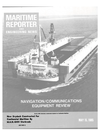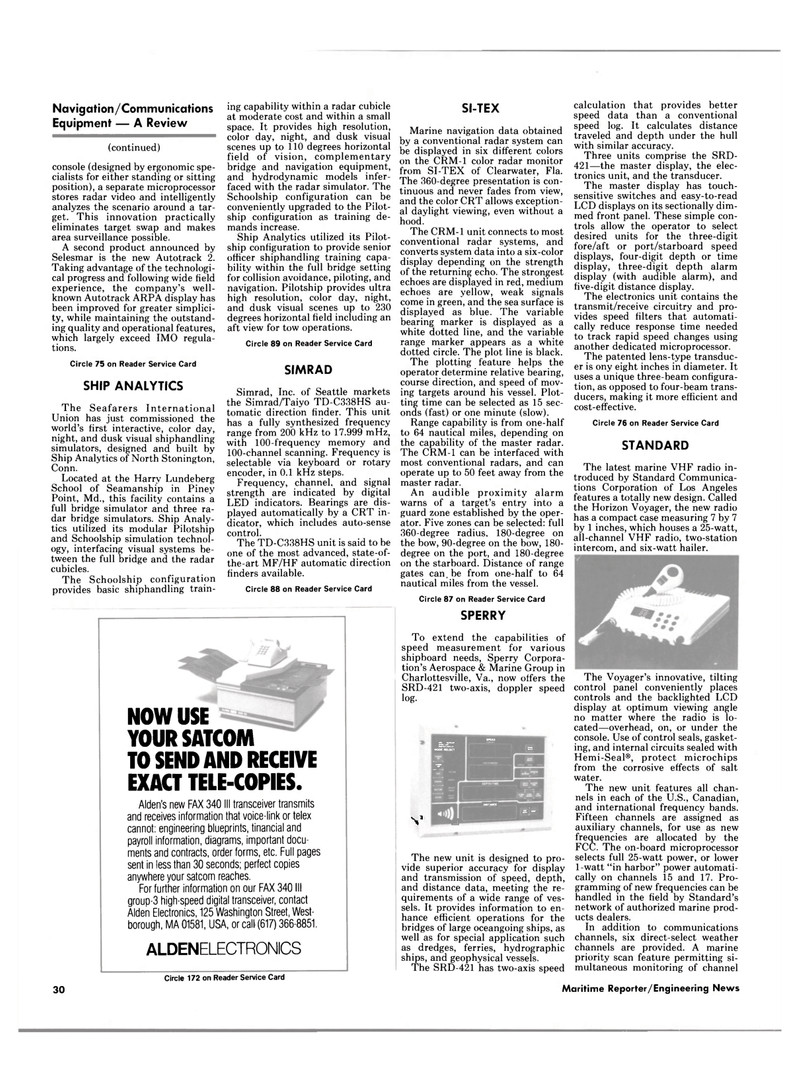
Page 30: of Maritime Reporter Magazine (May 15, 1985)
Read this page in Pdf, Flash or Html5 edition of May 15, 1985 Maritime Reporter Magazine
Navigation/Communications
Equipment — A Review (continued) console (designed by ergonomic spe- cialists for either standing or sitting position), a separate microprocessor stores radar video and intelligently analyzes the scenario around a tar- get. This innovation practically eliminates target swap and makes area surveillance possible.
A second product announced by
Selesmar is the new Autotrack 2.
Taking advantage of the technologi- cal progress and following wide field experience, the company's well- known Autotrack ARPA display has been improved for greater simplici- ty, while maintaining the outstand- ing quality and operational features, which largely exceed IMO regula- tions.
Circle 75 on Reader Service Card
SHIP ANALYTICS
The Seafarers International
Union has just commissioned the world's first interactive, color day, night, and dusk visual shiphandling simulators, designed and built by
Ship Analytics of North Stonington,
Conn.
Located at the Harry Lundeberg
School of Seamanship in Piney
Point, Md., this facility contains a full bridge simulator and three ra- dar bridge simulators. Ship Analy- tics utilized its modular Pilotship and Schoolship simulation technol- ogy, interfacing visual systems be- tween the full bridge and the radar cubicles.
The Schoolship configuration provides basic shiphandling train- ing capability within a radar cubicle at moderate cost and within a small space. It provides high resolution, color day, night, and dusk visual scenes up to 110 degrees horizontal field of vision, complementary bridge and navigation equipment, and hydrodynamic models inter- faced with the radar simulator. The
Schoolship configuration can be conveniently upgraded to the Pilot- ship configuration as training de- mands increase.
Ship Analytics utilized its Pilot- ship configuration to provide senior officer shiphandling training capa- bility within the full bridge setting for collision avoidance, piloting, and navigation. Pilotship provides ultra high resolution, color day, night, and dusk visual scenes up to 230 degrees horizontal field including an aft view for tow operations.
Circle 89 on Reader Service Card
SIMRAD
Simrad, Inc. of Seattle markets the Simrad/Taiyo TD-C338HS au- tomatic direction finder. This unit has a fully synthesized frequency range from 200 kHz to 17.999 mHz, with 100-frequency memory and 100-channel scanning. Frequency is selectable via keyboard or rotary encoder, in 0.1 kHz steps.
Frequency, channel, and signal strength are indicated by digital
LED indicators. Bearings are dis- played automatically by a CRT in- dicator, which includes auto-sense control.
The TD-C338HS unit is said to be one of the most advanced, state-of- the-art MF/HF automatic direction finders available.
Circle 88 on Reader Service Card
NOW USE
YOUR SATCOM
TO SEND AND RECEIVE
EXACT TELE-COPIES.
Alden's new FAX 340 III transceiver transmits and receives information that voice-link or telex cannot: engineering blueprints, tinancial and payroll information, diagrams, important docu- ments and contracts, order forms, etc. Full pages sent in less than 30 seconds; perfect copies anywhere your satcom reaches.
For further information on our FAX 340 III group-3 high-speed digital transceiver, contact
Alden Electronics, 125 Washington Street, West- borough, MA 01581, USA, or call (617) 366-8851.
ALDEN ELECTRONICS
SI-TEX
Marine navigation data obtained by a conventional radar system can be displayed in six different colors on the CRM-1 color radar monitor from SI-TEX of Clearwater, Fla.
The 360-degree presentation is con- tinuous and never fades from view, and the color CRT allows exception- al daylight viewing, even without a hood.
The CRM-1 unit connects to most conventional radar systems, and converts system data into a six-color display depending on the strength of the returning echo. The strongest echoes are displayed in red, medium echoes are yellow, weak signals come in green, and the sea surface is displayed as blue. The variable bearing marker is displayed as a white dotted line, and the variable range marker appears as a white dotted circle. The plot line is black.
The plotting feature helps the operator determine relative bearing, course direction, and speed of mov- ing targets around his vessel. Plot- ting time can be selected as 15 sec- onds (fast) or one minute (slow).
Range capability is from one-half to 64 nautical miles, depending on the capability of the master radar.
The CRM-1 can be interfaced with most conventional radars, and can operate up to 50 feet away from the master radar.
An audible proximity alarm warns of a target's entry into a guard zone established by the oper- ator. Five zones can be selected: full 360-degree radius, 180-degree on the bow, 90-degree on the bow, 180- degree on the port, and 180-degree on the starboard. Distance of range gates can, be from one-half to 64 nautical miles from the vessel.
Circle 87 on Reader Service Card
SPERRY
To extend the capabilities of speed measurement for various shipboard needs, Sperry Corpora- tion's Aerospace & Marine Group in
Charlottesville, Va., now offers the
SRD-421 two-axis, doppler speed log.
SuCT MOCK SCUCT
W*K> as
J* _J
OSTMKC sr.' — calculation that provides better speed data than a conventional speed log. It calculates distance traveled and depth under the hull with similar accuracy.
Three units comprise the SRD- 421—the master display, the elec- tronics unit, and the transducer.
The master display has touch- sensitive switches and easy-to-read
LCD displays on its sectionally dim- med front panel. These simple con- trols allow the operator to select desired units for the three-digit fore/aft or port/starboard speed displays, four-digit depth or time display, three-digit depth alarm display (with audible alarm), and five-digit distance display.
The electronics unit contains the transmit/receive circuitry and pro- vides speed filters that automati- cally reduce response time needed to track rapid speed changes using another dedicated microprocessor.
The patented lens-type transduc- er is ony eight inches in diameter. It uses a unique three-beam configura- tion, as opposed to four-beam trans- ducers, making it more efficient and cost-effective.
Circle 76 on Reader Service Card
STANDARD
The latest marine VHF radio in- troduced by Standard Communica- tions Corporation of Los Angeles features a totally new design. Called the Horizon Voyager, the new radio has a compact case measuring 7 by 7 by 1 inches, which houses a 25-watt, all-channel VHF radio, two-station intercom, and six-watt hailer.
Circle 172 on Reader Service Card
V
The new unit is designed to pro- vide superior accuracy for display and transmission of speed, depth, and distance data, meeting the re- quirements of a wide range of ves- sels. It provides information to en- hance efficient operations for the bridges of large oceangoing ships, as well as for special application such as dredges, ferries, hydrographic ships, and geophysical vessels.
The SRD-421 has two-axis speed
The Voyager's innovative, tilting control panel conveniently places controls and the backlighted LCD display at optimum viewing angle no matter where the radio is lo- cated—overhead, on, or under the console. Use of control seals, gasket- ing, and internal circuits sealed with
Hemi-Seal®, protect microchips from the corrosive effects of salt water.
The new unit features all chan- nels in each of the U.S., Canadian, and international frequency bands.
Fifteen channels are assigned as auxiliary channels, for use as new frequencies are allocated by the
FCC. The on-board microprocessor selects full 25-watt power, or lower 1-watt "in harbor" power automati- cally on channels 15 and 17. Pro- gramming of new frequencies can be handled in the field by Standard's network of authorized marine prod- ucts dealers.
In addition to communications channels, six direct-select weather channels are provided. A marine priority scan feature permitting si- multaneous monitoring of channel 30 Maritime Reporter/Engineering News

 29
29

 31
31
